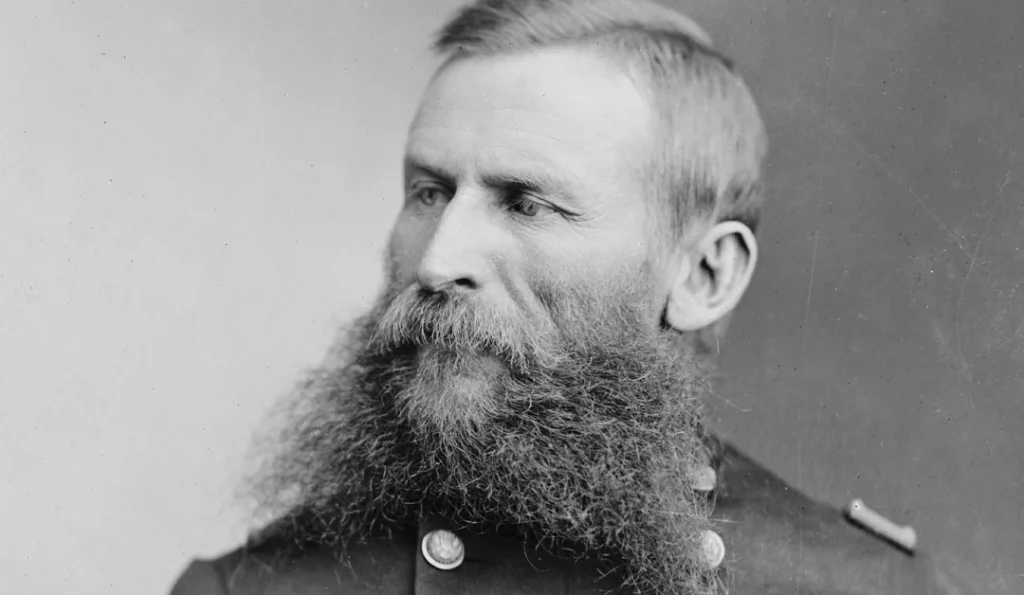September 8, 1828–March 21, 1890
George Crook was a noted officer in the United States Army during the American Civil War and the Indian Wars in the American West during the last half of the nineteenth century.
George Crook was born to Thomas and Elizabeth Crook on September 8, 1828, on a farm near Taylorsville, Ohio. Congressman Robert Schenck nominated Crook to the United States Military Academy, where Crook enrolled in 1848. Not an outstanding student, Crook graduated from West Point in 1852, thirty-eighth in his class of forty-three cadets.
After graduating from West Point, Crook was commissioned as a second lieutenant in the 4th U.S. Infantry and deployed to California and the Pacific Northwest, where he campaigned against American Indians. Crook was promoted to the rank of first lieutenant in 1856 and to captain in 1860.
When the American Civil War began, Crook was promoted to colonel of the 36th Regiment Ohio Volunteer Infantry on September 12, 1861, and he was sent to western Virginia. On September 7, 1862, Crook was promoted to brigadier general and was assigned to command a brigade of Ohio regiments in the Kanawha Division. Officials attached Crook’s brigade to the IX Corps in the Army of the Potomac during the Maryland Campaign. Ten days later, on September 17, 1862, Crook participated in the Battle of Antietam.
In 1863, Crook transferred to the Western Theater, where he commanded a cavalry division in the Army of the Cumberland under Major General George H. Thomas. While in the West, Crook participated in the Battle of Chickamauga (September 19 and 20, 1863).
In February 1864 Crook, returned to western Virginia, now West Virginia, resuming command of the Kanawha Division, officially designated the 2nd Division in the Department of West Virginia. On May 9, 1864, Crook led his division to victory at the Battle of Cloyd’s Mountain, in Pulaski County, Virginia. In August of that year, officials named Crook commander of the Army of Western Virginia, which was designated the 8th Corps of Ohioan and Major General Philip Sheridan’s Army of the Shenandoah. As commander of the 8th Corps, Crook contributed to Union victories at the Battles of Opequon (September 19, 1864), Fisher’s Hill (September 21 and 22, 1864), and Cedar Creek (October 19, 1864). Two days after the Union victory at Cedar Creek, officials promoted Crook as a major general of volunteers.
At the conclusion of Sheridan’s Valley Campaign, Crook’s army went into winter quarters near Cumberland, Maryland. There, Rebel partisans captured Crook as he slept on the night of February 21, 1865. The Confederates imprisoned Crook in Libby Prison in Richmond, Virginia, for one month until he was released as part of a prisoner exchange on March 20. After his release, Crook commanded a cavalry division in the Army of the Potomac during the Appomattox Campaign.
Following the end of the Civil War, Crook married Mary Tapscott Daily on August 22, 1865, in Allegany County, Maryland. When officials disbanded the volunteer army, Crook received a brevet promotion to major general in the regular army, but he reverted to his formal rank of lieutenant colonel and returned to the Pacific Northwest.
Crook served another twenty-five years in the West, where he earned a reputation as a successful Indian fighter. From 1865 to 1868, Crook campaigned against the Snake Indians during the Snake War in the Pacific Northwest. In 1871, fellow Ohioan and President Ulysses S. Grant placed Crook in command of the Arizona Territory. In 1873, officials promoted Crook to the rank of brigadier general.
Crook commanded the Department of the Platte from 1875 to 1882. While in that position, he campaigned against the Sioux Indians during the Great Sioux War of 1876-1877. Some critics contend that Crook contributed to Lieutenant Colonel George Custer’s disastrous defeat at the Battle of the Little Bighorn on June 25, 1876, because he unexpectedly returned to his supply base after a standoff with Sioux Indians at the Battle of the Rosebud on June 17, rather than pressing forward in support of Custer’s 7th Cavalry.
In 1882, Crook returned to Arizona and campaigned against Geronimo and the Chiricahua Apaches. Although Crook captured Geronimo twice, the Indian warrior managed to escape each time. As a result of Crook’s ineffectiveness against the Apaches, Brigadier General Nelson Miles replaced Crook as commander of the Arizona Territory in 1886.
Crook returned to command of the Department of the Platte from 1886 to 1888. In 1888, officials promoted him to the rank of major general and appointed him as the head of the Division of the Missouri (formerly the Department of the West), headquartered in Chicago. Crook died suddenly from a heart attack in Chicago, on March 20, 1890. Initially, Crook was buried in Oakland, Maryland. On November 11, 1898, his body was re-interred at Arlington National Cemetery.
During the last years of his life, Crook spoke out against the unjust treatment of his former Indian adversaries. The Indian chief Red Cloud said of Crook, “he never lied to us. His words gave us hope”.
Related Entries
- Battle of Chickamauga
- Ulysses S. Grant
- Philip Henry Sheridan
- Battle of Antietam
- Appomattox Campaign
- Battle of Fisher’s Hill
- Battle of Opequon
- Battle of Cloyd’s Mountain
- Sheridan’s Valley Campaign
- Army of the Cumberland
- Army of the Potomac (USA)
- Army of the Shenandoah (USA) (1864)
- General Orders, No. 181 (U.S. War Department)
- General Orders, No. 234 (U.S. War Department)
- General Orders, No. 248 (U.S. War Department)
